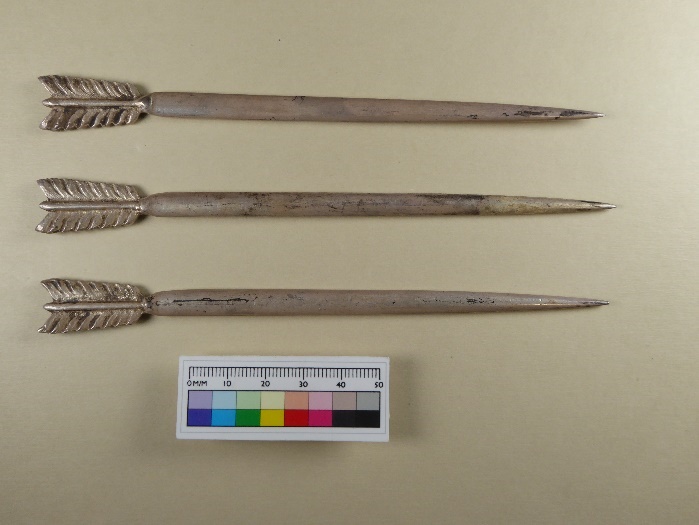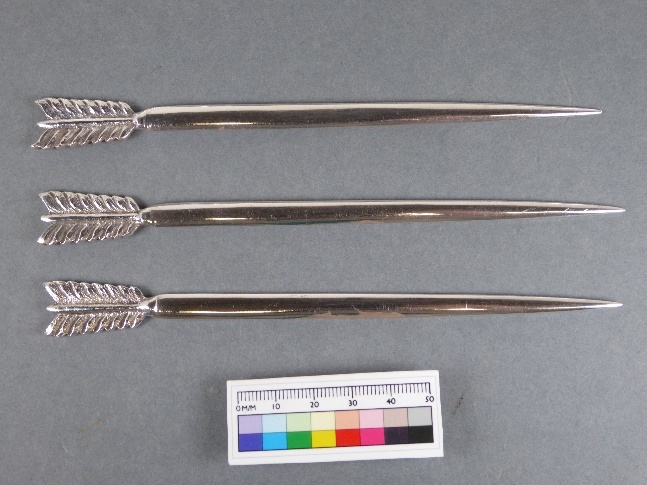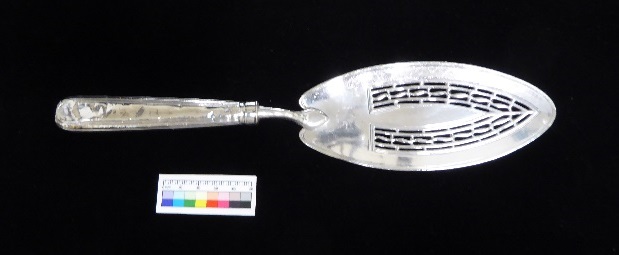Durham Castle Historic Silver – Student Post

Before heading off for winter break, we got our first taste of treating historic objects in the conservation lab. We had the pleasure of working on pieces of University College’s historic silver collection from Durham Castle. A variety of silver objects made their way into the conservation lab including both functional tableware items, such as meat skewers and a fish knife, and more symbolic items, such as commemorative cups.
The objects were in need of cleaning, to remove the build up of tarnish, and coating, to protect against future tarnishing. Silver tarnish is the result of how silver chemically reacts with the oxygen and hydrogen sulphide present in air to form silver sulphide. Acanthite, a mineral form of silver sulphide, forms on the surface of silver presenting either as a thin yellow layer or a thick black layer—silver tarnish.

The first step in the cleaning process was to remove the old accession numbers from the objects with acetone and a microfiber cloth. Then the tarnish was tackled by gently cleaning the objects with an appropriate solution for historic metals using a microfiber cloth. For objects with intricate areas, such as the lattice of the fish knife (below), a small round soft brush was used to apply the solution. The objects were then cleaned in the same manner with acetone to insure the removal of any residual solution.

Once cleaned, the objects were coated with Renaissance Micro-Crystalline Wax. Two different application methods were used: cold waxing and hot waxing. Objects that were cold waxed, such as the fish knife, had the wax applied cold with a microfiber cloth, left for a short length of time and then buffed off with another microfiber cloth. Objects that were hot waxed, such as the meat skewers, were heated with an appropriate appliance until the surface of the metal was hot to touch and then the wax was applied with a microfiber cloth and then buffed off once cooled.
The final step was to re-apply the accession number to the object, which was achieved by carefully writing with a fountain pen using Windsor and Newton Ink on top of a protective polymer layer.

A few of the objects, like the fish knife, had visible makers’ marks and stamps that enabled us to learn about the object’s history. The fish knife had stamps on both the handle and blade demonstrating that it was a composite object. One of the stamps on the handle could be identified as the markers’ mark of Mathew Boulton of Birmingham. While the marker’s mark on the blade is most likely that of William Eley and William Fearn. Additionally, the stamps on the blade indicate that the silver met the sterling standard and was made in London in 1802 during the reign of George III.
Finding out such information is what makes working with historic objects so exciting, and we are looking forward to getting more experience working with historic and museum objects this semester.
Casey.
